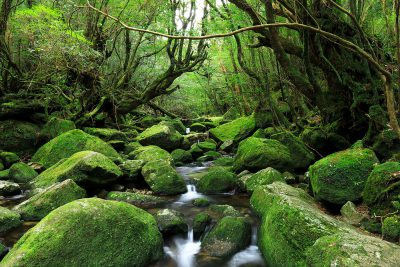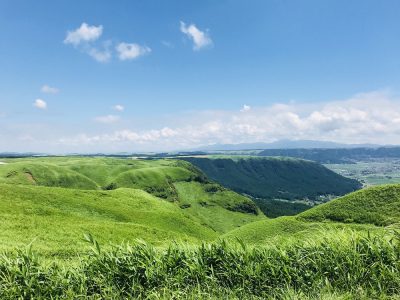When you think about Japan, some of the first images that spring to mind are Mt Fuji, cherry blossoms, and bamboo forests. Japan’s natural beauty is famed all over the world, and so is Japan’s love of nature. This nature love goes back thousands of years and keeps returning as a popular muse for all kinds of art. What’s the history of Japan’s relationship with nature? And how can you immerse yourself in nature when you travel to Japan?
History of Nature Love
For the over 10,000 years spanning from the Jomon period through today, the Japanese have looked at forests and the mountains that nurture forests with reverence and awe. Near 70% of the Japanese landmass is forest and mountains. As can be seen in Japan’s main religion Shinto, Japanese people have appreciated life in all aspects of nature for a long time. Whether it is the landscapes, the clean water coming from the mountains, or the seasonal changes, in Japan people actually stand still to appreciate the bounty around them.

Art has been heavily inspired by nature throughout the ages. There are countless drawings and paintings of cherry blossoms and autumn leaves. And in Japanese poetry like waka and haiku, it is almost a rule that an element of nature should always make an appearance. Their respect for natural life enables them to coexist with nature. You could say that the origin of Japanese values and culture lies in Japanese people’s close relationship with nature.
It also helps that Japan’s natural bounty is incredibly diverse. There are many larger and smaller islands that each have their own biodiversity. Japan is also spreading quite large from north to south, and the climate is very different in Hokkaido and Okinawa.
Pilgrimages in Japan
One of the best ways to appreciate nature in Japan is to walk a (part of a) pilgrimage. There are 3 very famous pilgrimage routes in Japan; the Kumano Kodo in Wakayama, the trails around Koyasan, and the 88 temple route in Shikoku. Of course, the main point of walking a pilgrimage is to grow spiritually and to visit important temples and shrines. The routes have been walked for hundreds of years by many pilgrims before you. And most would agree that being surrounded by nature on their walk has been a spiritual experience in itself.

The Kumano Kodo and Koyasan are situated in natural areas without large cities nearby. So it will be easy to feel that you are worlds away from your regular life if you are a city dweller. The route in Shikoku does lead to temples in small cities as well, but most of the route is away from the crowds. Shikoku’s largest city is just over 500.000 people strong, so there are no metropoles in the pilgrimage. If you want to see a lot of nature on your trip to Japan, walking a part of a pilgrimage route is a great option.
Forest Bathing
Since the beginning of time, woods have been the inspiration for many stories and visual artworks. They are mysterious and enchanting, and trees have a great influence on all living things on earth. Our forests are a lifeline for us. Besides supplying us with wood and other resources, they also provide a space for relaxation and contemplation.

For humans, forests are a kind of lifeline. They supply wood and other resources indispensable to our everyday activities and provide spaces for rest and relaxation. Going to a forest just to immerse yourself in the lush green environment even has its own term in Japanese. ‘Shinrin yoku’ literally means ‘forest bathing’, and it is practiced by many who feel worn out by daily life in the city.
Forest bathing allows us to reconnect with our inner selves and truly be in the here and now. In that way, it is related to Zen Buddhism which had a great impact on Japanese culture. Just breathing the fresh air, seeing the many shades of green and the way the sunlight filters through the trees is a healing experience. Japan has many places that are great for a forest bath. Near Tokyo, most people go to Mt Takao, but if you want to go a bit deeper you could go to the Japan Alps or even as far as Yakushima.
Nature Love on Other Islands
Most tourists stay on Japan’s main island, Honshu, for their whole trip. Cities like Tokyo, Kyoto, and Hiroshima are all situated on Honshu. While Honshu has plenty to offer in terms of natural beauty, it also pays off to discover the other islands of Japan. Okinawa’s Main Island and smaller islands are a subtropical paradise where you can indulge in activities such as hiking, diving, and snorkeling. Shikoku is also great for going off-the-beaten-path and getting disconnected from the modern world.

I would like to give a special mention to Hokkaido and Kyushu. These islands are both paradises for those looking for natural beauty in Japan. Hokkaido, Japan’s northernmost island, has a moderate climate with cold winters. This is one of the reasons why Hokkaido is quite sparsely populated apart from Sapporo. There are amazing National Parks such as Daisetsuzan, Akan Mashu, and Shiretoko. Birders will literally have a field day in Hokkaido. And you can see interesting natural phenomena such as moringa and drift ice.

Kyushu is very volcanic, and therefore incredibly green and fertile. Mt Aso has some of the most amazing views in the world. And there are many natural hot springs on the island. Beppu is especially famed for its many healing onsen. The Takachiho Gorge is a typical bucket list destination with its otherworldly views. And Aoshima has a geological formation that is hard to find anywhere else in the world.
As you can see, there are so many wonderful natural beauty spots to find in Japan. It is no wonder that appreciation for all this charm is all around in Japan!
Your Japan Tour
As seasoned Japan experts, we create perfect Japan package tours including wonderful natural beauty spots. Check out our group tours and private tours, or contact us to start planning your unforgettable holiday to this fascinating country. Japan is full of once-in-a-lifetime experiences, culture, history, nature, and delicious food!